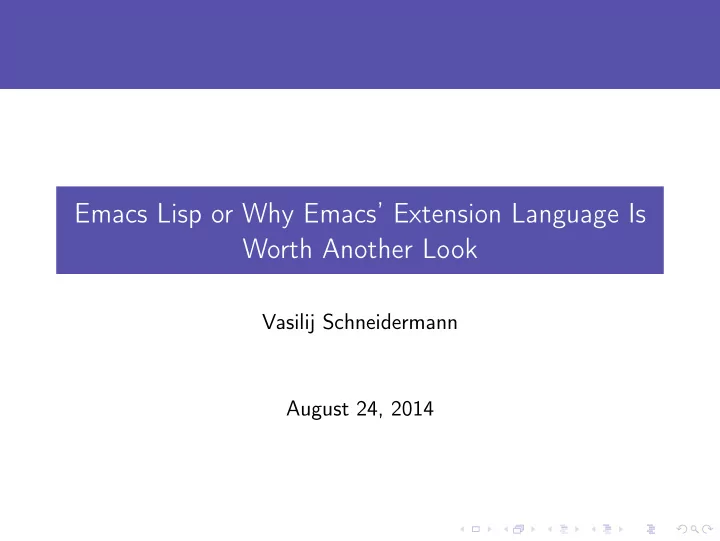

Emacs Lisp or Why Emacs’ Extension Language Is Worth Another Look Vasilij Schneidermann August 24, 2014
Outline 1 Introduction 2 How I got started with Emacs and Emacs Lisp 3 Why I didn’t want to learn Emacs Lisp at first 4 History 5 Strengths 6 Weaknesses 7 What do?
Section 1 Introduction
Speaker Vasilij Schneidermann, 22 Information systems student Working at bevuta IT, Cologne v.schneidermann@gmail.com https://github.com/wasamasa
Preliminary notes Pretty subjective at times Prepare for dogfooding
What this talk will be about Emacs features Demonstrations of what Emacs can do The community
What this talk will not be about Teaching you how to use Emacs Editor wars
Section 2 How I got started with Emacs and Emacs Lisp
How I got started with Emacs and Emacs Lisp Started out with switching text editors constantly Became curious, learned Vim Wanted more, tried Emacs Stuck with Emacs, didn’t want to learn Emacs Lisp at first Curiosity took over, read sources of small packages Learned to prefer reading source over docs Small fixes at first, wrote own packages later Eventually dug in deep enough to hold a talk about it
Section 3 Why I didn’t want to learn Emacs Lisp at first
It’s a Lisp, Lisps are functional languages! Lisp doesn’t mean it’s a functional language Emacs Lisp itself is rather procedural dash.el helps if you want it to be more functional
It’s a Lisp, therefore it must be useless! Emacs is (probably) the largest open Lisp project out there There’s a few thousand packages one can install
So, there must be nothing useful left to write anymore! There’s more than enough things lacking Add your own ideas and you’ll have something useful to write
I want to learn a real Lisp first! It is a real Lisp and a good starting point If you can’t decide which one to go for, learn it first, then proceed depending on how much you like it
I don’t want to learn a completely different language just to customize a text editor! Starting out is very simple Transition to more complex code is gradual
The existing tutorials and the manual are too intimidating, I want something more approachable! Introduction to reading code and customization: http: //sachachua.com/blog/series/read-lisp-tweak-emacs/ Minimal tutorial, REPL-centric: http://bzg.fr/learn-emacs-lisp-in-15-minutes.html More traditional introduction to concepts: http://harryrschwartz.com/2014/04/08/ an-introduction-to-emacs-lisp.html Exactly what it says on the tin: http://steve-yegge. blogspot.com/2008/01/emergency-elisp.html
Section 4 History
History RMS disliked Unix, had the idea to create a completely free OS He started writing his own compiler, didn’t like Vi He started writing an extensible editor that was able to do more than a mere text editor would He chose Lisp as the extension language everything apart the fundamentals would be implemented in He also made it free to distribute and added a clause that people had to contribute improvements back, way before they were using DVCS Later development moved from the cathedral to the bazaar style
Section 5 Strengths
Rich runtime Lots of Emacs Lisp tooling Serialization/Unserialization of XML, HTML, JSON Datetime/Calendar, Color, Unmarshaling File handling, recoding Numerical analysis, graphing Parsers, DBus, Terminal Emulation Wrappers for Mail, IRC, Printing, VCS, GPG, . . . Network processes and access/requests Process control . . .
Event-driven Color selection with mouse (vivid-rodent.el)
Event loop Play back frames with timeout, control playback (flipbook.el)
Buffers are powerful State visualization (svg-2048.el, svg-2048-animation-demo.el)
Complex UI is possible Trigger evaluation in different buffer with keyboard input (dial.el) Magit and makey, org-export UI
More productivity Access often used functionality in a simpler way (helm-fkeys.el)
Better workflow Switch window configurations in a simpler way (eyebrowse)
Immediate feedback loop commence fixing/writing code to make a more practical point (svg-2048.el)
Section 6 Weaknesses
No APIs / Crufty APIs Very little or weird abstraction
Speed Need to escape to external processes / FFI Byte-compilation helps a bit (with macros)
Historical mistakes The C codebase is scary Complexity of the display engine No namespaces BZR Weird naming conventions
There’s still a lot to be fixed
Section 7 What do?
Programmers Join the Mailing List, hang out on #emacs at Freenode Improve your Emacs Lisp skills Understand existing code, discuss and question it Write demos to find better approaches to a problem
Designers & Writers “Design is about pulling things apart.” - Rich Hickey Gifcasts Clearer documentation Suggest (UI) ideas, discuss them Devise APIs and better abstractions
Rewrite proponents See Guile Emacs
Possible stuff to hack on A “native” torrent client Guile Emacs and things using Guile bindings (graphical browser, video player, OpenGL, . . . ) dired Window management library Input methods helm dash.el, s.el, f.el, b.el, . . . my stuff other people’s stuff (see next slide)
Hackers to collaborate with Fuco1 magnars skeeto chrisdone purcell thierryvolpiatto bbatsov technomancy dgutov . . .
Conclusion Emacs is pretty cool You should totally learn to mold it to your likings If you do, help out while you’re at it There’s more than enough to be fixed
Questions? “<technomancy> not making sense never stopped an intrepid elisper!”
Recommend
More recommend